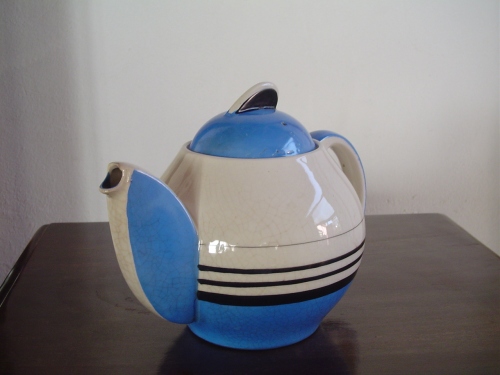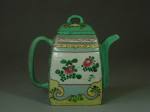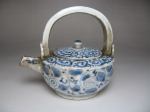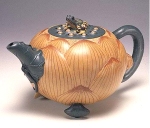Here is a pair of beautiful Nippon vases in a lovely celestial blue and pink pattern. The hand painted landscape scene depicts a lake, trees, a little house and a pretty sky. Both have the same image and both are painted this same way front and back. The moriage work is used to frame the landscape. The decoration is inspired by the late-Rococo porcelain styles of Germany and France. There is some loss of gold on the Japanese Chin (*) dog handles, and normal signs of wear as appropriate with age. Unmarked, but I believe this to be original Nippon porcelain from the late 19th Century or early 20th Century. Measurements: Height: 5.9″
(*) The Japanese Chin, also known as the Japanese Spaniel is another dog breed that resembles Chinese guardian lions , also called Fu (or Foo) Lions, and originates in China. Professor Ludvic von Schulmuth studied canine origins by studying the skeletal remains of dogs found in human settlements as long as ten thousand years ago. The Professor created a genealogical tree of Tibetan dogs that shows the “Gobi Desert Kitchen Midden Dog”, a scavenger, evolved into the “Small Soft-Coated Drop-Eared Hunting Dog”. From this dog evolved the Tibetan Spaniel, Pekingese, and Japanese Chin.
Nippon Porcelain
The Japanese did not begin exporting their porcelain until the 17th century. It was at that time that a civil war caused the Chinese exporting to halt, prompting the Dutch to convince the Japanese to begin exporting to fill the European demand for porcelain.
Nippon porcelain production began in 1891, when exporting to America was opened, and ended in 1921 when a tariff stating that items had to be plainly marked in English was enacted. The name Nippon simply means Japan. It is not a type of porcelain, but rather a time period that porcelain contained the mark of Nippon.
In general, unmarked Nippon is prior to March 1891; however, this is not a hard and fast rule. Until import laws were clarified, some USA ports allowed goods to enter the country as long as the crate or box was marked with the originating country.
In its day, the Nippon porcelain was inexpensive and often seen as not worthy of collecting. Today, it is not only popular in America, but also Japan and very expensive to collect.
Pieces such as vases, pots and plates were decorated using distinctive decorating techniques. Nippon porcelain was wholly hand painted until 1904. After 1904, piece began appearing with decals and stencil designs. Many of them were decorated using materials which are no longer available nowadays. It would be very difficult to bring these techniques and materials back into today’s ceramic industry. The decorating techniques include the following:
Moriage 盛り上げ
Moriage is the term used to describe the layering of small beads or lines of slip clay onto the surface of the pottery, vase or bowl to create three dimensional decorative effects.
There are three basic methods for applying the moriage designs. One is by hand rolling and shaping. The second makes use of tubing. The tubing was filled with softened clay and applied to the porcelain much as we decorate cakes today. The third technique is to reduce the clay to a liquid state and brush it on items. Moriage designs are innumerable and varied. They include border trimmings, lacy designs, and floral motifs.
Kin-mori 金盛 or Gold Moriage 金彩
The Moriage were often painted gold after the glaze had been applied, giving the pottery item a unique and special finish. The beads were all placed onto the pottery by hand before it was fired in the kiln. Later, when the mass production of such items was started, the addition of the slip clay beads was replaced by adding small dots of enamel which speeded up the production time of each of the items.
Jewel ジュエル
This is a raised decoration using glassy pigments that looks like a jewel embedded in the enamel. The colours used are red, yellow, blue, green, and pink. Also known as “Hoseki-mori”.
Cobalt コバルト
Cobalt blue was the primary blue pigment used in Chinese blue and white porcelain for centuries, beginning in the late 8th or early 9th century.
Cerulean blue is much used for colouring pottery, and consists of 79 parts of grey flux (fondant aux gris), 7 of carbonate of cobalt, 14 hydrated carbonate. The name of this 19th blue pigment was based on the Latin word “caeruleum” (sky or heavens) previously used in Classical Antiquity to refer to numerous blue pigments. The quite numerous versions of cobalt cerulean already offer quite a various range of undertones.
Designs デザインパターン
Images and patterns are drawn directly onto ceramics by highly skilled craftsmen. These designs are based on complicated, elegant curves and light pastel colours. The paintings were greatly influenced by traditional European decorative style.
Landscape 風景
Portrait ポートレート





























































































































































































































































































